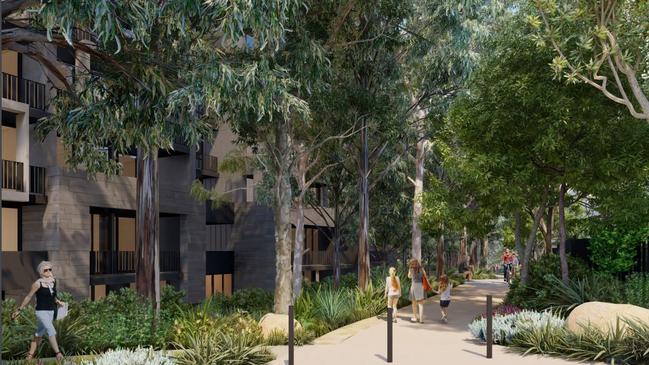Mirvac rides housing boom with higher profit as Covid hits tenants
The developer is cautious about retail rent collections after the outbreak of Omicron, but its residential unit is firing ahead.

Property developer Mirvac is confident that it can defy an interest rate hike by the Reserve Bank later this year as buyers cashed up from the house price boom switch into apartments.
The developer gave cautious earnings guidance as it deals with the impact of the Omicron outbreak but says that it has costs under control even in the face of supply chain blockages and rising labour expenses.
The company is not concerned about higher rates hitting buyers and instead sees its shopping centre and apartments business as leveraged to the reopening of international borders and immigration.
“We feel very resilient towards that given our focus not on the marginal first home buyer or the investor market, but our focus is on the owner occupier market, including right-sizes and upgraders,” Mirvac chief executive Susan Lloyd-Hurwitz said
The Mirvac chief also pointed to the lack of supply as fewer apartments would be completed in the next financial year, with industry-wide completion levels at about 45 per cent in 2018.
Mirvac posted a 44 per cent jump in first half profit to $565m as it rides the ongoing residential property boom and the fallout from the pandemic.
Ms Lloyd-Hurwitz struck a cautious note on the short term outlook and kept guidance unchanged saying the developer would closely monitor the operating environment.
“While we had expected to see conditions normalise in the first half of 2022, the spread of Omicron has presented a number of challenges,” Ms Lloyd-Hurwitz said.
The Mirvac chief cited supply chain constraints and labour shortages on business activity and warned that the extension of the commercial code of conduct for retail tenants was “likely to put pressure on cash collection rates in the short term”.
The extended lockdowns last year hit the performance of Mirvac‘s investment holdings, particularly its shopping centres, but this was offset by strength in its development businesses.
Despite these challenges, Ms Lloyd-Hurwitz is confident and says that the retail businesses had come off the bottom, with an increase in valuations and leasing spreads improving.
The company said it was now well-placed.
“Our strong balance sheet, the secure income stream from our high-quality investment portfolio, our robust commercial development pipeline, and a high level of residential pre-sales ensures our business remains resilient,” Ms Lloyd-Hurwitz said.
The residential business had strong sales momentum, despite the roll-off of government stimulus, with 95 per cent of forecast earnings before interest and tax for this financial year already secured.
The company has also struck several major pre-leases to get new projects off the ground and is also advancing mixed use projects in Sydney and Melbourne.
Mirvac recorded a 9 per cent lift in operating profit to $297m, representing 7.5 cents per security. It raised its half year distribution by 6 per cent to 5.1 cents per security.
On the residential side, Ms Lloyd-Hurwitz said Mirvac had a robust pipeline of projects bought well, which is expected to support future residential earnings.
“Despite the roll off of stimulus measures, we continue to see strong demand from upgraders, right-sizes, and first-home buyers who are attracted to our reputation as a trusted developer,” she said.
The developer also said that broader fundamentals remain positive, with limited supply, pent up demand and the impending return of overseas migration.
The company‘s residential arm delivered earnings of $89m, a 17 per cent lift, driven by higher lot settlements, largely from residential estates. It settled 1,303 residential lots and is on track to deliver more than 2,500 lot settlements this financial year.
Defaults also fell back below 2 per cent, in line with historical averages. The company exchanged 1,814 lots during the quarter, skewed to land estates, with strong sales particularly in Melbourne projects.
Residential pre-sales increased to about $1.5bn and the company released more than 1,580 lots, including the launch of four major apartment projects in Sydney and Melbourne.
Jarden analysts said Mirvac had a positive result from a residential momentum perspective, with settlements growing 21 per cent against the prior period, and defaults back to historic levels with 95 per cent of this year‘s earnings secured.
“However, exposure to CBD retail and, to a lesser extent, office has impacted trust portfolio performance in the first half and could well remain mixed looking ahead near term,” Jarden said.
They said that the full-year guidance looked to assume a resumption of normalised business activities in this half but noted the market was looking for at least a small upgrade.
Macquarie analysts said the operating earnings were 7 per cent below consensus expectations but Mirvac had reaffirmed its guidance of at least 15 cents per security for this financial year.
They cited the impacts of Omicron and said that while earnings could be softer than market expectations, the commercial and residential development pipeline would drive growth from next financial year onwards.
Mirvac dipped by 7 cents to $2.564.




To join the conversation, please log in. Don't have an account? Register
Join the conversation, you are commenting as Logout